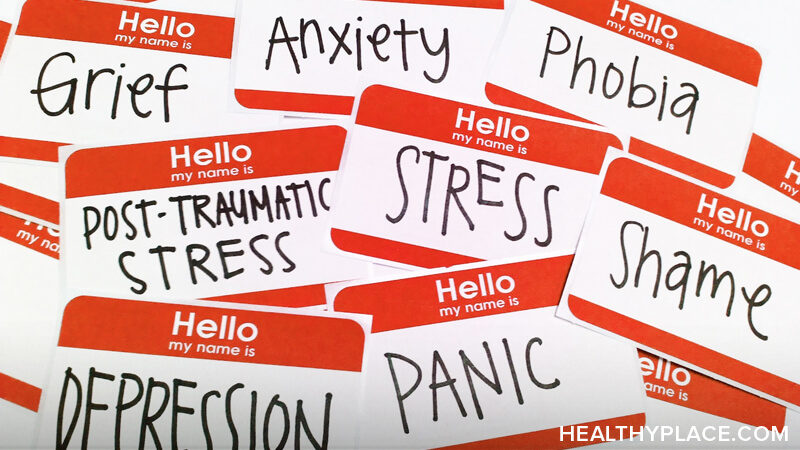List of Mental Illnesses

A list of mental illnesses is a valuable tool. After all, the term mental illness is incredibly broad and encompasses a great many examples of mental illnesses and disorders. Having a list of mental illnesses to refer to when exploring what you or someone close to you might be experiencing can help you tame the jungle of information (How Do You Know If You Have A Mental Illness?).
The Officially Accepted List of Mental Illnesses
The recognized authority on mental illness types, descriptions, and criteria is the Diagnostic and Statistical Manual of Mental Disorders, Fifth Edition (DSM-5), published by the American Psychiatric Association (2013). It contains 20 chapters that delineate and describe all of the known mental disorders, well over 200. The chapters are organized logically, and each disorder within a chapter shares features in common with the others.
Below is a list of each mental illness disorder chapter in the DSM-5; it's a general list of mental illnesses. The list contains broad types of mental illnesses by category, but of course, each category contains multiple, more specific, mental illnesses.
Mental Illnesses List
Neurodevelopmental Disorders
These disorders involve problems, specifically with the brain, during development. The problems negatively impact life functioning. Typically, they begin in early childhood. They include: attention deficit hyperactivity disorder (ADHD), autism spectrum disorder (ASD), communication disorders, intellectual developmental disorder, motor disorders, and specific learning disorders. It’s not unusual for these disorders to co-exist.
Schizophrenia Spectrum and Other Psychotic Disorders
Disorders in this category involve psychosis, which is an episodic break from reality. Hallucinations (sensing things that aren't there) or delusions (believing things that aren't true or real) are the hallmarks of psychotic disorders (Schizophrenia and Psychosis: Hallucinations and Delusions). Other characteristics are present, too, depending on the specific disorder.
Bipolar and Related Disorders
These mood disorders involve extremes in affect (outward manifestation of emotions). The swings range from depression to mania, and they vary in severity according to the specific disorder (take the Mood Disorder Questionnaire - MDQ).
Depressive Disorders
Another type of mood disorder, depressive disorders are characterized, among other symptoms, by prolonged depressed mood and loss of interest in activities.
Anxiety Disorders
Anxiety disorders share in common intense worry and fear that affect thoughts, feelings, and behaviors, and physiology (digestive troubles, etc.)
Obsessive-Compulsive and Related Disorders
Obsessive-compulsive and related disorders involve extreme recurrent thoughts or preoccupations connected to behaviors, mental or behavioral, done to alleviate the obsessions.
Trauma- and Stressor-Related Disorders
Trauma- and stressor-related disorders, such as posttraumatic stress disorder, are mental disorders resulting from outside forces. While they result from various types of injury, they significantly impact and/or alter the brain itself, thus qualifying as mental disorders.
Dissociative Disorders
With dissociative disorders, there's a disruption in the functioning of consciousness, memory, identity, or perception. Amnesia, senses of being unreal (depersonalization), or of the world being unreal (derealization) are some of the symptoms of these disorders.
Somatic Symptom and Related Disorders
Disorders in this category relate to physical symptoms that resemble a medical condition despite the fact that there is no medical evidence that the condition is present. This doesn't include physical symptoms associated with anxiety disorders.
Feeding and Eating Disorders
Extreme disturbances in eating behavior and nutrition are the hallmarks of eating disorders.
Sleep-Wake Disorders
These disorders involve disruptions somewhere in the sleep-wake cycle. Included features involve changes in the length/amount of sleep.
Elimination Disorders
Elimination disorders are those in which urine or feces is voided in inappropriate places, either voluntarily or involuntarily.
Sexual Dysfunctions
Disorders involving sexual dysfunctions are those that relate to disturbances in sexual desire and response.
Gender Dysphoria
Gender dysphoria is a significant difference in the gender someone was born into and his/her experienced gender (Multi-Dimensionality of Gender).
Disruptive, Impulse-Control, and Conduct Disorders
Children with conduct disorders present with irritable, angry, and/or disruptive behavior. Disobedience and other clashes with authority figures are common, and law-breaking behavior can also be present in this category.
Substance-Related and Addictive Disorders
This category includes the use or abuse of 10 separate classes of drugs. Gambling behavior is also included here.
Neurocognitive Disorders
This category encompasses disorders/diseases of the brain that contribute to decline in cognitive functioning and processing.
Personality Disorders
The 10 main disorders in this category involve deeply ingrained behavior patterns and inflexible responses to various personal and social situations.
These aren't included in the same section of the DSM-5 as mental illnesses. Not every professional agrees on whether or not personality disorders are mental illnesses due to the nature of the disorders and historical lack of evidence of brain dysfunction. As more becomes known about the brain, this may (or may not) change (Difference Between Mental Illness and Mental Disorder).
Paraphilic Disorders
Paraphilic disorders are ones that involve recurrent and intense sexual urges, fantasies, or behaviors. They involve unusual objects, activities, or situations.
Other Mental Disorders
This broad category is reserved for mental disorders that share symptoms with another mental disorder(s), are problematic, but don't meet the full diagnostic criteria of the disorder.
These categories, in the list of mental illnesses, provide an overview of the many different mental illnesses that people live with. Knowing the specifics of each category and each disorder within the categories creates understanding. Understanding brings empathy for individuals living with mental illness as well as hope that treatment and management are possible.
APA Reference
Peterson, T.
(2019, October 23). List of Mental Illnesses, HealthyPlace. Retrieved
on 2024, November 20 from https://www.healthyplace.com/other-info/mental-illness-overview/list-of-mental-illnesses



